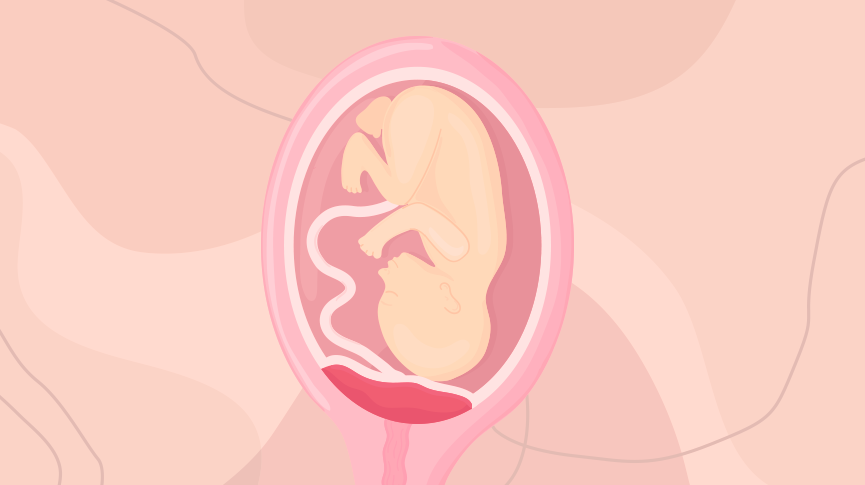Pregnancy Complications: Placenta Previa

Many people don’t realize how many things go into growing a human until they go through it themselves. Things don’t always go according to plan, especially when different complications arise. Understanding different pregnancy potential outcomes can help you plan accordingly and know your options – especially if you experience any sort of complication. One potential complication is what’s called “placenta previa.”Let’s learn more about this condition, what causes it, and how it may affect your pregnancy and birth.
What is The Placenta?
Before we can explain placenta previa, let’s brush up on our placenta knowledge. The placenta is an organ that grows specifically for and during pregnancy. Its role is to transport nutrients, oxygen, blood, and antibodies from the pregnant parent to the baby. It also helps transport waste from the fetus back to the parent, protects the fetus from infections, and helps to regulate pregnancy hormones. The placenta grows during pregnancy and similarly is birthed after the baby at the end of pregnancy. Although the placenta is vital for the pregnancy and development of the fetus, it can also come with potential issues.
What is Placenta Previa?
Such is the case with placenta previa. This is when the placenta grows in the bottom part of the uterus, and covers part of or all of the opening to the cervix. Placenta previa occurs in about 1 out of 200 pregnancies. The cervix is the opening between the uterus and the vagina. Amongst other jobs, its main role during vaginal birth is to dilate so that the baby can come out. As you can imagine, it can cause difficulties if this passageway is blocked by the placenta. The placenta moves throughout pregnancy and the uterus stretches and grows. Sometimes a person may have placenta previa in the beginning or middle of their pregnancy, but the placenta typically moves to the top of the uterus before delivery. This isn’t always the case though.
There are three different types of placenta previa:
- Complete: When the placenta covers the entire cervical opening.
- Partial: When the placenta covers part of the cervix.
- Marginal: When the placenta is next to the cervix without covering it.
What Causes Placenta Previa?
While the exact cause of placenta previa is unknown, some things can increase someone’s risk factor of developing it.
- Many previous pregnancies
- Have carried multiples before (twins, triplets, etc.)
- People who have undergone in vitro fertilization (IVF)
- Having an abnormally shaped uterus
- Previous placenta previa
- Smoking
- Older maternal age (after 35)
- Scarring on the uterus from a previous C-section, abortion, or other surgery
Placenta Previa Complications
If undiagnosed before birth, placenta previa can cause serious complications including hemorrhage, and potential morbidity and mortality to the baby and pregnant parent. Placenta previa is one of the leading causes of third-trimester hemorrhage. This is because the uterus is unable to contract properly to stop the flow of blood from open vessels when the placenta detaches after birth.
Thanks to advances in ultrasound technology, placenta previa is often diagnosed at an earlier stage in pregnancy. That being said, about 90% of “low-lying” placenta on an early ultrasound are no longer present in the third trimester. For those that persist until birth, there is a higher risk of premature delivery (less than 34 weeks gestation), or early delivery (34-37 weeks). There is also an increased risk of emergency hysterectomy after delivery, postpartum endometritis, and higher rates of blood transfusions. Bleeding in the second and third trimesters is usually due to abnormal positioning of the placenta.
Complications for the infant include:
- Jaundice
- Admission to the neonatal intensive care unit (NICU)
- Congenital malformations
- Fetal anemia
- Abnormal presentation during labor
- Low birth weight
- Fetal growth restriction
- Neonatal respiratory distress syndrome
- Neonatal mortality
Placenta Previa Treatment
Placenta previa is typically detected through an ultrasound. It may also be detected after an episode of painless vaginal bleeding. There is no treatment for placenta previa outside of birth. Instead, treatment focuses on management to avoid further complications. One of the main goals of treatment is to limit bleeding while getting you as close as possible to your due date.
If diagnosed with placenta previa, patients are often directed to decrease activity to avoid further bleeding. They also may need to avoid sexual intercourse and pelvic examinations. You may be given medicine to prevent preterm labor, or corticosteroid shots to help your baby’s lungs develop faster. For people with complete placenta previa, cesarean delivery is required for birth. If you’ve had a placenta previa in previous pregnancies, it’s important to notify your provider during any subsequent pregnancies, as you may have an increased risk of developing it again. If you are pregnant, know that you are doing the best you can to take care of yourself and your baby. For more education on your growing body and preparing for birth, you can also learn about doulas, what to pack in your birth bag and pregnancy and birth terms from A to Z.

Natasha (she/her) is a full-spectrum doula and health+wellness copywriter. Her work focuses on deconstructing the shame, stigma, and barriers people carry around birth, sex, health, and beyond, to help people navigate through their lives with more education and empowerment. You can connect with Natasha on IG @natasha.s.weiss.


